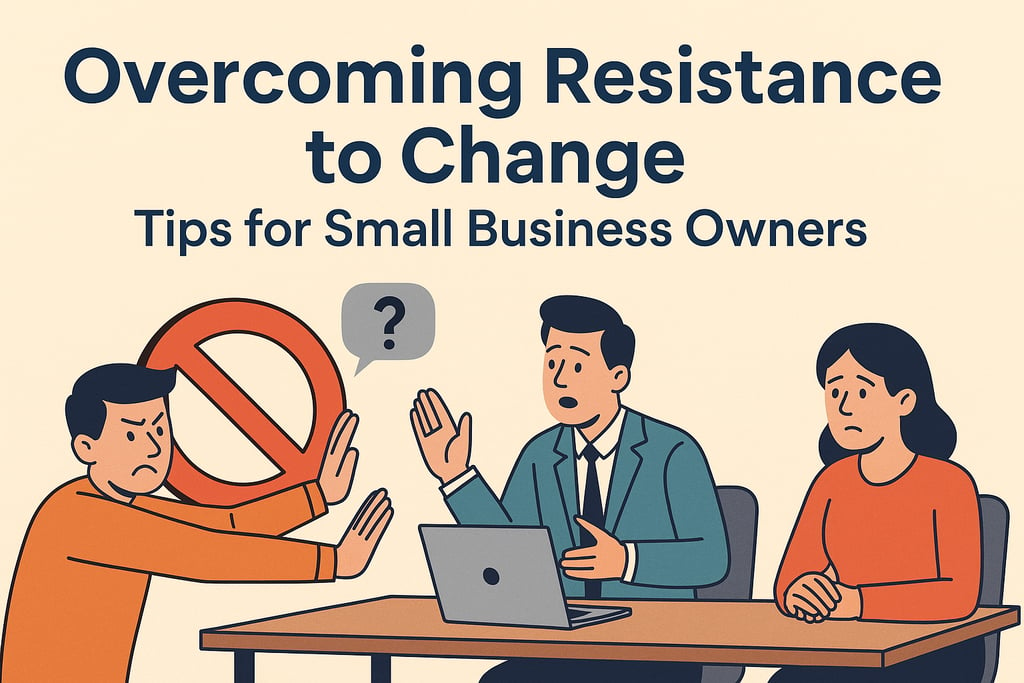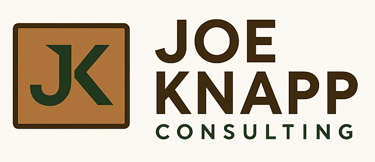Overcoming Resistance to Change: Tips for Small Business Owners
Struggling with resistance to change in your small business? Discover practical tips to get your team on board.
SMALL BUSINESSBUSINESS IMPROVEMENTCHANGE MANAGEMENTTEAM DYNAMICSBUSINESS GROWTHLEADERSHIP
Joe Knapp
6/24/20254 min read


Overcoming Resistance to Change: Tips for Small Business Owners
Hi there! If you’ve ever tried rolling out something new—like a tool to manage appointments or track inventory—you’ve probably noticed your team wasn’t jumping for joy. I’ve been there. When I helped schools, doctor’s offices, and small shops set up automated systems, the staff often paused. They’d leaned on paper records or old habits for years, and switching felt like a leap into the unknown. I get it—change is hard. But after years at US Netcom figuring out better ways to work and now helping businesses like yours through Joe Knapp Consulting, I’ve learned a few tricks to smooth things out and make change stick.
Resistance isn’t a sign your idea’s a dud—it’s just a nudge to slow down and connect. I don’t have every answer, but I’ve got some practical strategies that work. Let’s dive into why people push back and how you can bring your team along, keeping it real for your small business.
Why Do People Resist Change?
Here’s what I’ve seen over the years:
Fear of the Unknown: Old routines feel like a cozy blanket. I worked with a retail shop where the team clung to paper records because it’s what they knew—even though it ate up hours every week. I’ve even seen multi-million dollar organizations run on Excel spreadsheets with limited visibility. Familiar feels safe, even when it’s inefficient.
Unclear Benefits: If your crew can’t see what’s in it for them—like less stress on hectic days—they’ll dig in their heels. I’ve heard “Why mess with what works?” plenty of times. Your team will buy into the change once they see how it improves their lives—whether that’s saving time, reducing errors, or just making their day smoother.
Bad Past Experiences: If a shiny new tool flopped before—like a glitchy system that crashed mid-day—they’re wary. I once helped a business that got burned by a failed automation attempt; they needed proof this time would be different. (And I’ve seen it go sideways—like the time a client accidentally called an entire university due to a tech mix-up. Rebuilding trust took time, but we got there.)
Lack of Clarity: If you’re pumped about a change but your team’s scratching their heads, you’ve got a problem. I’ve seen owners excited about a new setup, but without clear explanations, the staff just felt lost.
Pinpointing the “why” behind the pushback is your first move.
Practical Tips to Ease the Transition
Here’s what’s worked for me helping businesses like yours switch things up:
Take It Slow: Don’t overhaul everything at once. Start small—like testing a new point-of-sale system on just one type of sale. Think of the change as an experiment. Implement small. Prove it out. Then grow it. It’s less overwhelming, and your team can see it working without the pressure of a total flip.
Show the Payoff: Let the results speak. In that retail shop, we tracked how the new system shaved time off inventory checks. Hard numbers helped, but so did pointing out, “Hey, this actually works.” Real proof beats promises every time. Show them the return on their investment in time and money—whether it’s fewer errors, faster processes, or happier customers.
Hear Them Out: Ask what’s bugging them. One employee thought the new system would pile on work—I sat with her, listened, and showed how it’d lighten her load. She went from skeptical to sold because she felt heard. Listening builds trust faster than any sales pitch.
Keep It Real: Share what you’ve seen. I’ve told teams about my US Netcom days, where automated notifications cut hours of phone tag. It’s not some sales pitch—it’s just what happened, and they trust that. Be honest about what’s worked and what hasn’t—you’re not here to oversell, just to help.
Open the Door: Give them space to talk. Set up a quick coffee chat or a casual check-in where they can vent or ask questions. I did this with a team, and it turned into a goldmine of honest feedback that made the change better. It’s not about forcing the idea—it’s about understanding their side.
It’s not magic, and it takes some elbow grease, but these steps make it doable.
Warning Signs to Watch For
Resistance can sneak up on you. Here’s what to look out for:
Silent Nods: If they’re all nodding but nobody’s talking when you pitch the idea, they’re not on board—they’re confused. Dig deeper with a question like, “What’s on your mind?” to get the real conversation going.
Problem Dumping: If little complaints keep popping up, they might not trust the change. One staffer kept nitpicking a system until we dug deeper—she was worried about her role, not the tech. Address the root cause, not just the surface gripe.
Bare Minimum Effort: When they’re just checking boxes instead of digging in, they’ve checked out. I noticed this with a team and called a huddle to reset and refocus. Sometimes, a quick “What’s holding you back?” can reopen the door.
Team Disconnect: If the usual chatter and teamwork fade, the change might be throwing them off. I’ve fixed this with a low-key team activity to get everyone back in sync—like a shared lunch or a quick problem-solving session.
Spot these early, and a quick chat can turn it around.
A Real Example from My Work
Here’s one from the trenches: A doctor’s office I worked with was drowning in no-shows—patients forgetting appointments left their schedule in chaos. We set up a simple text reminder system. At first, the staff was jittery—would it work? Would patients hate it? We tested it with a handful of folks, and soon they saw fewer empty slots and less time chasing people down. One receptionist grinned and said, “This is a game-changer.” It wasn’t instant, but it clicked, and that’s the kind of win I live for.
Final Thoughts
I’m just getting started with Joe Knapp Consulting, but I’ve been at this a while—first at US Netcom, then in large corporate environments, and now helping businesses like yours. Change isn’t about big talk; it’s about what fits your world. Start small, prove it works, listen up, and keep it straight. That’s how you make it last.
What’s your story? Hit a wall with a new idea lately? Drop a comment—I’d love to swap notes on what’s worked for you!
Joe Knapp Consulting, LLC
Waste Less, Profit More
© 2025 Joe Knapp Consulting, LLC. All rights reserved. | Privacy Policy
How I Help
Save Time with automation and smarter tools
Reduce Costs by cutting waste and complexity
Increase Profits through efficient, tech-driven growth
The Socials
Helping small businesses simplify technology and grow with confidence.
